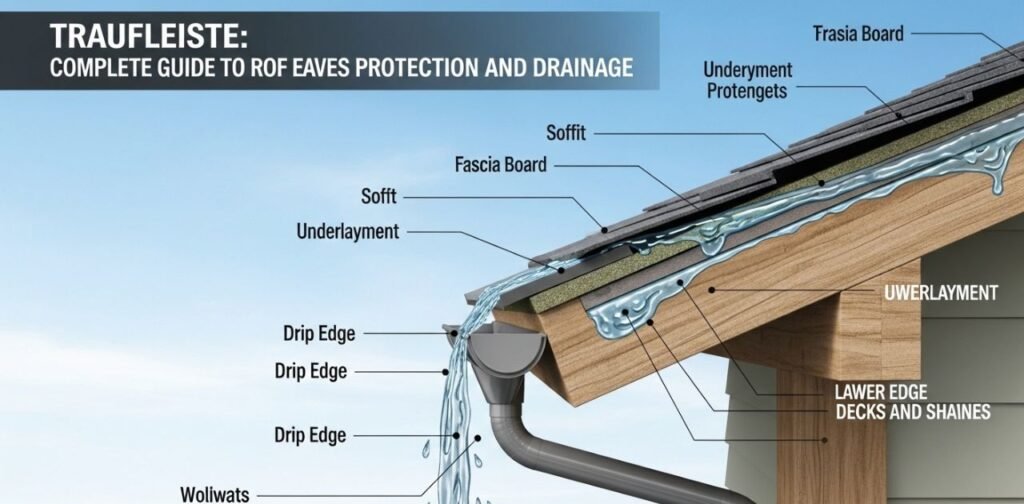Introduction
When it comes to roofing, small details often make the biggest difference. One such detail is the Traufleiste, an essential component in modern and traditional roof construction. In simple terms, a Traufleiste is a drip edge or eaves flashing—a metal strip installed at the edge of a roof to guide rainwater into the gutter and prevent moisture damage to wooden elements and walls.
Although it looks like a small addition, the Traufleiste plays a critical role in roof longevity, moisture protection, and energy efficiency. Without it, water could seep under the roof covering, damage the underlayment, or even rot the wooden rafters. Over time, this leads to expensive repairs.
In this guide, we’ll explore everything you need to know about the Traufleiste: what it is, why it matters, different materials and types, installation tips, and how to choose the right one for your home. Whether you are a builder, roofer, or homeowner looking to upgrade your roof system, this article will give you valuable insights.
What is a Traufleiste and Why is it Important?
The Traufleiste is a narrow strip of metal that sits at the bottom edge of the roof, where the roof slope meets the gutter. Its main function is to ensure that rainwater is directed safely into the gutter, preventing it from running down the fascia board or underneath the roofing material.
Here’s why the Traufleiste is so important:
- Moisture Protection – By preventing water from reaching sensitive wooden components, it extends the life of the roof structure.
- Improved Drainage – Water is guided directly into the gutter, reducing overflow or splashing against walls.
- Aesthetic Finish – The metal edge creates a clean, professional look, enhancing the roofline.
- Compatibility with Underlay – Modern roofing systems use underlayment foils or membranes, and the Traufleiste ensures that these layers drain properly into the gutter.
- Energy Efficiency – By keeping insulation dry, it indirectly helps maintain thermal efficiency.
In countries like Germany, building codes often require the use of a Traufleiste for proper roof drainage. Even where it’s not mandatory, roofers highly recommend it as a preventive measure. Without it, roofs are exposed to water intrusion risks that shorten their lifespan.
Types of Traufleiste: Materials and Variations
Not all Traufleisten are the same. Depending on the roofing style, climate, and budget, different materials and profiles are available:
- Aluminum Traufleiste
- Lightweight and corrosion-resistant.
- Ideal for modern roofs and easy to install.
- Often comes with powder coating for color customization.
- Stainless Steel Traufleiste
- Very durable and long-lasting.
- Resistant to rust even in harsh climates.
- Slightly more expensive but ideal for premium roofing.
- Galvanized Steel Traufleiste
- Affordable and strong.
- Coated with zinc to resist corrosion.
- Requires maintenance to prevent rust in the long term.
- Copper Traufleiste
- Traditional, elegant look.
- Extremely durable with natural patina over time.
- Often used in historic or luxury projects.
In addition to materials, Traufleisten also differ in profiles and sizes. Some are straight, while others have angled bends to better fit specific roof geometries. Choosing the right one depends on the roof slope, gutter system, and underlay you’re using.
How to Install a Traufleiste Correctly
Proper installation is key to the effectiveness of a Traufleiste. Even the best material won’t work if installed incorrectly. Here’s a simplified step-by-step overview:
- Preparation
- Ensure the roof underlayment and fascia board are properly fixed.
- Choose a Traufleiste that matches the gutter size and roof pitch.
- Positioning
- Place the Traufleiste along the roof edge, ensuring the lower lip extends into the gutter.
- Overlap sections by a few centimeters to avoid gaps.
- Fixing
- Secure the Traufleiste with roofing nails or screws.
- Make sure it’s flush and aligned for smooth water flow.
- Integration with Underlayment
- The roofing underlay should extend over the Traufleiste, allowing any water that seeps under the shingles/tiles to drain into the gutter.
- Final Check
- Pour some water as a test to see if it flows directly into the gutter without leaking behind.
Professional roofers often install Traufleisten as part of the complete roofing process, but skilled DIYers can also manage it if safety precautions are followed. The most important thing is ensuring seamless water drainage and no gaps.
Benefits of Using a Traufleiste in Modern Roofing
Adding a Traufleiste to your roof system comes with multiple benefits beyond just water protection:
- Extended Roof Life – By protecting wooden rafters and fascia boards, it reduces repair costs.
- Protection Against Mold – Dry surfaces prevent mold growth and improve indoor air quality.
- Structural Safety – Keeps insulation and underlayers dry, preserving their function.
- Cost Efficiency – A small investment compared to the long-term cost of roof repairs.
- Design Enhancement – Available in different finishes, Traufleisten can match roof tiles or facade colors.
Many homeowners underestimate this component, but professionals know it is as important as roof tiles or gutters. Without it, the risk of hidden water damage increases significantly.
Buying Guide: How to Choose the Right Traufleiste
If you’re planning to install or replace a Traufleiste, here are factors to consider:
- Material Quality – Stainless steel and copper offer the best durability, while aluminum is great for modern lightweight roofs.
- Roof Type – Flat roofs, pitched roofs, and tile roofs may require different profiles.
- Climate Conditions – In coastal or rainy regions, corrosion-resistant materials are essential.
- Budget – Galvanized steel is cost-effective, but premium materials last longer with less maintenance.
- Aesthetic Fit – Choose a color or coating that blends with your roofline.
Investing in the right Traufleiste ensures long-term safety and reduces maintenance headaches.
Frequently Asked Questions (FAQs)
1. What is the main function of a Traufleiste?
It guides rainwater into the gutter and protects the roof edge from moisture damage.
2. Is a Traufleiste required for every roof?
While not always legally required, it is highly recommended for durability and water protection.
3. Which material is best for a Traufleiste?
Stainless steel and copper are the most durable, while aluminum offers a lightweight, modern option.
4. Can I install a Traufleiste myself?
Yes, if you have roofing experience and proper safety equipment. Otherwise, professional installation is recommended.
5. How long does a Traufleiste last?
Depending on the material, it can last 20–50 years with minimal maintenance.
6. Does a Traufleiste improve roof aesthetics?
Yes, it gives the roofline a clean finish and can be color-matched to tiles or gutters.
7. Can a Traufleiste prevent leaks completely?
It significantly reduces the risk of leaks at the eaves, but proper roof installation is equally important.
Conclusion
The Traufleiste may seem like a small roofing detail, but its impact on roof protection and durability is huge. By guiding rainwater into the gutter and shielding wooden components from moisture, it ensures a longer roof lifespan, healthier insulation, and reduced repair costs.
As modern construction moves toward energy-efficient and sustainable solutions, the role of the Traufleiste becomes even more important. By keeping insulation dry, it helps maintain thermal performance, contributing to lower energy bills and a more eco-friendly home.
Looking to the future, we may see smart roofing systems where Traufleisten are integrated with sensors to monitor water flow, detect blockages, or alert homeowners of potential damage. But even without such innovations, the traditional Traufleiste remains an indispensable part of roofing.
Whether you’re building a new home, renovating, or simply maintaining your property, never overlook this essential component. A small strip of metal at the edge of your roof can save you thousands in repairs and give you peace of mind for decades.


